| Listing 1 - 7 of 7 |
Sort by
|
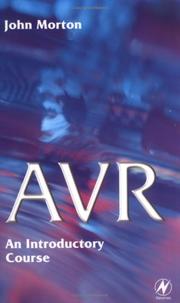
ISBN: 9781435605527 1435605527 0080499724 9780080499727 9780750656351 0750656352 9786611034962 1281034967 9781281034960 Year: 2002 Publisher: Oxford : Newnes,
Abstract | Keywords | Export | Availability | Bookmark
 Loading...
Loading...Choose an application
- Reference Manager
- EndNote
- RefWorks (Direct export to RefWorks)
This book includes 15 programming and constructional projects, and covers the range of AVR chips currently available, including the recent Tiny AVR. No prior experience with microcontrollers is assumed.John Morton is author of the popular PIC: Your Personal Introductory Course, also published by Newnes.*The hands-on way of learning to use the Atmel AVR microcontroller*Project work designed to put the AVR through its paces*The only book designed to get you up-and-running with the AVR from square one
Book
ISBN: 0070204535 9780070204539 Year: 1994 Publisher: New York: McGraw-Hill,
Abstract | Keywords | Export | Availability | Bookmark
 Loading...
Loading...Choose an application
- Reference Manager
- EndNote
- RefWorks (Direct export to RefWorks)
Computer architecture. Operating systems --- Computer architecture. --- Reduced instruction set computers. --- Ordinateurs --- Architecture --- Computer architecture --- Reduced instruction set computers --- Ordinateurs à jeu d'instructions réduit --- Ordinateurs à jeu d'instructions réduit
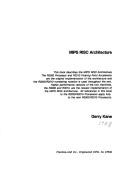
ISBN: 0135847494 Year: 1987 Publisher: Englewood Cliffs, NJ : Prentice Hall,
Abstract | Keywords | Export | Availability | Bookmark
 Loading...
Loading...Choose an application
- Reference Manager
- EndNote
- RefWorks (Direct export to RefWorks)
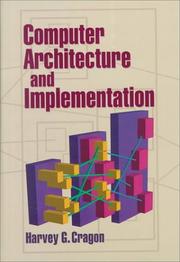
ISBN: 0521651689 0521657059 Year: 2000 Publisher: Cambridge : Cambridge university press,
Abstract | Keywords | Export | Availability | Bookmark
 Loading...
Loading...Choose an application
- Reference Manager
- EndNote
- RefWorks (Direct export to RefWorks)
Computer architecture. --- Ordinateurs --- Architecture --- Computer architecture --- #KVIV:BB --- 681.31 --- CISC complex instruction set computers --- I/ O-interface --- RISC reduced instruction set computers --- cache geheugens --- geheugenadressering --- geheugens --- hardware --- instructieset --- processoren --- Architecture, Computer --- Computerarchitectuur. Informaticahardware. --- Computerarchitectuur. Informaticahardware
Book
ISBN: 2100717936 9782100717934 Year: 2014 Publisher: Paris : Dunod,
Abstract | Keywords | Export | Availability | Bookmark
 Loading...
Loading...Choose an application
- Reference Manager
- EndNote
- RefWorks (Direct export to RefWorks)
Vous avez envie de concevoir des montages avec Arduino ou Raspberry Pi qui interagissent avec leur environnement ?Pour cela vous avez besoin de capteurs, et cet ouvrage vous aidera à passer rapidement des idées à la réalisation. Chaque chapitre est consacré à un type de capteur (mouvement, lumière, son, etc.) et comporte : (-) des expériences qui expliquent la manière d’utiliser un capteur ; (-) des tests de validation ; (-) un mini-projet qui montre comment combiner différentes technologies pour obtenir un montage performant. Les nombreux exemples de code commentés vous seront précieux pour créer vos propres projets. Les montages que vous pourrez réaliser : (-) un éthylotest personnel, (-) un détecteur de fumée qui envoie un courriel d’alerte, (-) une sonnette hantée qui sonne avant qu’on ne la touche, (-) un jeu vidéo Pong, (-) un dôme lumineux sensible à la couleur, (-) un écran graphique qui réagit aux sons ambiants, (-) une station météo…
Arduino (microcontrôleur) --- Capteurs. --- Microcontrôleurs --- Microordinateurs --- Ordinateurs à jeu d'instructions réduit. --- Raspberry Pi (Ordinateur) --- Programmation. --- Arduino (Programmable controller) --- Detectors --- Microcontrollers --- Microcomputers --- Reduced instruction set computers --- Raspberry Pi (Computer) --- Arduino (Automate programmable) --- Détecteurs --- Micro-ordinateurs --- Ordinateurs à jeu d'instructions réduit --- Programming --- Programmation --- Capteurs (technologie) --- Raspberry Pi (ordinateur) --- Détecteurs --- Microcontrôleurs --- Ordinateurs à jeu d'instructions réduit --- Detectors.
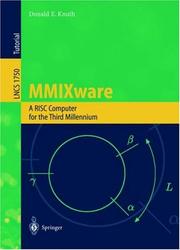
ISBN: 3540669388 3540466118 Year: 1999 Publisher: Heidelberg : Springer,
Abstract | Keywords | Export | Availability | Bookmark
 Loading...
Loading...Choose an application
- Reference Manager
- EndNote
- RefWorks (Direct export to RefWorks)
MMIX is a RISC computer designed by Don Knuth to illustrate machine-level aspects of programming. In the author's book series "The Art of Computer Programming", MMIX replaces the 1960s-style machine MIX. A particular goal in the design of MMIX was to keep its machine language simple, elegant, and easy to learn. At the same time, all of the complexities needed to achieve high performance in practice are taken into account. This book constitutes a collection of programs written in CWEB that make MMIX a virtual reality. Among other utilities, an assembler converting MMIX symbolic files to MMIX objects and two simulators executing the programs in given object files are provided. The latest version of all programs can be downloaded from MMIX's home page. The book provides a complete documentation of the MMIX computer and its assembly language. It also presents mini-indexes, which make the programs much easier to understand. A corrected reprint of the book has been published in August 2014, replacing the version of 1999.
MMIX (Computer architecture) --- Computer architecture --- Reduced instruction set computers --- Computer Science --- Engineering & Applied Sciences --- Computer architecture. --- Reduced instruction set computers. --- RISCs (Computers) --- Architecture, Computer --- Computer science. --- Computer hardware. --- Computer organization. --- Software engineering. --- Computers. --- Algorithms. --- Application software. --- Computer Science. --- Software Engineering/Programming and Operating Systems. --- Computer Applications. --- Computer Hardware. --- Computer Systems Organization and Communication Networks. --- Computation by Abstract Devices. --- Algorithm Analysis and Problem Complexity. --- Computers --- Computer network architectures. --- Computer software. --- Software, Computer --- Computer systems --- Architectures, Computer network --- Network architectures, Computer --- Informatics --- Science --- Computer software engineering --- Engineering --- Algorism --- Algebra --- Arithmetic --- Automatic computers --- Automatic data processors --- Computer hardware --- Computing machines (Computers) --- Electronic brains --- Electronic calculating-machines --- Electronic computers --- Hardware, Computer --- Cybernetics --- Machine theory --- Calculators --- Cyberspace --- Organization, Computer --- Electronic digital computers --- Application computer programs --- Application computer software --- Applications software --- Apps (Computer software) --- Computer software --- Foundations --- Evaluation.
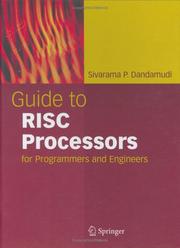
ISBN: 1280337230 9786610337231 0387274464 0387210172 144191935X Year: 2005 Publisher: New York : Springer,
Abstract | Keywords | Export | Availability | Bookmark
 Loading...
Loading...Choose an application
- Reference Manager
- EndNote
- RefWorks (Direct export to RefWorks)
Recently, there has been a trend toward processor design based on the RISC (Reduced Instruction Set Computer) model: Example RISC processors are the MIPS, SPARC, PowerPC, ARM, and even Intel’s 64-bit processor Itanium. This guidebook provides an accessible and all-encompassing compendium on RISC processors, introducing five RISC processors: MIPS, SPARC, PowerPC, ARM, and Itanium. Initial chapters explain the differences between the CISC and RISC designs and clearly discuss the core RISC design principles. The text then integrates instruction on MIPS assembly language programming, thereby enabling readers to concretely grasp concepts and principles introduced earlier. Readers need only have a basic knowledge of any structured, high-level language to obtain the full benefits here. Features: *Includes MIPS simulator (SPIM) download instructions, so that readers can get hands-on assembly language programming experience *Presents material in a manner suitable for flexible self-study • Assembly language programs permit reader executables using the SPIM simulator • Integrates core concepts to processor designs and their implementations • Supplies extensive and complete programming examples and figures • Contains chapter-by-chapter overviews and summaries * Provides source code for the MIPS language at the book’s website Guide to RISC Processors provides a uniquely comprehensive introduction and guide to RISC-related concepts, principles, design philosophy, and actual programming, as well as the all the popular modern RISC processors and their assembly language. Professionals, programmers, and students seeking an authoritative and practical overview of RISC processors and assembly language programming will find the guide an essential resource. Sivarama P. Dandamudi is a professor of computer science at Carleton University in Ottawa, Ontario, Canada, as well as associate editor responsible for computer architecture at the International Journal of Computers and Their Applications. He has more than two decades of experience teaching about computer systems and organization. Key Topics * Processor design issues * Evolution of CISC and RISC processors * MIPS, SPARC, PowerPC, Itanium, and ARM architectures * MIPS assembly language * SPIM simulator and debugger * Conditional execution * Floating-point and logical and shift operations * Number systems Computer Architecture/Programming Beginning/Intermediate Level.
Reduced instruction set computers. --- Computer architecture. --- Assembler language (Computer program language) --- Microprocessors --- Programming. --- Assembler languages (Electronic computers) --- Programming languages (Electronic computers) --- Architecture, Computer --- RISCs (Computers) --- Computers --- MMIX (Computer architecture) --- Computer science. --- Microprogramming. --- Software engineering. --- Computer network architectures. --- Processor Architectures. --- Control Structures and Microprogramming. --- Software Engineering/Programming and Operating Systems. --- Computer Systems Organization and Communication Networks. --- Programming Techniques. --- Computer software engineering --- Engineering --- Computer programming --- Informatics --- Science --- Architectures, Computer network --- Network architectures, Computer --- Computer architecture --- Microprocessors. --- Microprogramming . --- Computer organization. --- Computer programming. --- Electronic computer programming --- Electronic data processing --- Electronic digital computers --- Programming (Electronic computers) --- Coding theory --- Organization, Computer --- Minicomputers --- Programming --- Assembly languages (Electronic computers)
| Listing 1 - 7 of 7 |
Sort by
|

 Search
Search Feedback
Feedback About UniCat
About UniCat  Help
Help News
News